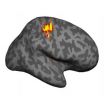(Press-News.org) Mitochondria, which are probably derived from distant bacterial ancestors incorporated into our cells, have their own DNA. However, we know little about how these organelles, which convert oxygen and consumed nutrients into energy, regulate the expression of their own genes. Jean-Claude Martinou, professor at the University of Geneva (UNIGE), Switzerland, and his team, have discovered the existence of compartments at the heart of mitochondria, consisting of hundreds of different proteins. It is here that RNA molecules (the many copies made from DNA) come together to be processed and begin their maturation. Equipped with enzymatic hardware of all sorts, these assembly plants, named 'mitochondrial RNA granules', are described in the journal Cell Metabolism. Many pathologies associated with mitochondrial disorders may be caused by dysfunctional mitochondrial RNA granules.
Mitochondria, present in varying numbers in each of our cells, are true power plants. These organelles actually produce energy from the combustion of nutrients, to be used by the cell to perform its daily tasks. Unlike other cell organelles, which are only subject to the laws dictated by the cell's DNA, mitochondria possess their own genome. This is probably the result of a symbiosis, which occured during the course of evolution, between their distant bacterial ancestors and cells of that time.
'All in one' transcription of DNA
Human mitochondrial DNA codes specifically for various proteins involved in the molecular equipment used to produce energy. This genetic material is transcribed into long RNA molecules - copies - which are comprised of both instructions for making proteins and the 'tools' to assemble them. This type of layout, in the form of an 'all in one kit', represents another bacterial.
"We don't really know how mitochondria regulate the expression of their genes. These long precursor RNA molecules, which do not exist anywhere else in the cell, must be processed in a distinctive way, with machinery specific to this organelle", reveals Jean-Claude Martinou, professor in the Department of Cell Biology, of the Faculty of Science. In collaboration with researchers from the University of Newcastle, his team has taken on the task of elucidating this type of structure.
Diseases linked to mutations in mitochondrial DNA
"Specifically, we tracked RNA molecules that we rendered fluorescent and observed their convergence and accumulation in previously unknown compartments" reports Alexis Jordan, a member of the group and first author of the article. "Made up of hundreds of different proteins, these are relatively large structures." Among these proteins are several enzymes known to play a role in the transformation of RNA into active entities. The precursor RNA molecules gathered in these compartments are thus sliced into sections corresponding to their various components: the instructions for building each protein, and the various 'tools' used to assemble them.
"These assembly plants, which concentrate the machinery to process RNA, were baptized 'mitochondrial RNA granules'. It is now possible to explore in more detail the different stages of mitochondrial RNA maturation and to understand its mechanism", explains Jean-Claude Martinou, an assertion whose importance is underlined by the fact that different pathologies are associated with dysfunctions in the processing of this RNA. The researchers intend to determine whether mutations in the RNA granule machinery are involved in the development of some of these diseases.
### END
How cells optimize the functioning of their power plants
Researchers at UNIGE, Switzerland, uncover veritable 'assembly plants' in mitochondria, the organelles responsible for energy production
2013-03-05
ELSE PRESS RELEASES FROM THIS DATE:
Single gene might explain dramatic differences among people with schizophrenia
2013-03-05
March 5, 2013 (Toronto) – Some of the dramatic differences seen among patients with schizophrenia may be explained by a single gene that regulates a group of other schizophrenia risk genes. These findings appear in a new imaging-genetics study from the Centre for Addiction and Mental Health (CAMH).
The study revealed that people with schizophrenia who had a particular version of the microRNA-137 gene (or MIR137), tended to develop the illness at a younger age and had distinct brain features – both associated with poorer outcomes – compared to patients who did not have ...
Viruses: More survival tricks than previously thought
2013-03-05
Among eukaryotes with modified nuclear genetic codes, viruses are unknown. Until now it had been believed that the modifications to the genetic code effectively prevented new viral infections. However, researchers have now reported the first example of a virus that can be shown to have crossed the boundary from organisms using the standard genetic code to those with an alternate genetic code.
"The finding is significant because it means that virus-host co-evolution after a genetic code shift can be more extensive than previously thought", said researcher Derek J. Taylor, ...
West Nile virus passes from female to eggs, but less so from larvae to adults
2013-03-05
In California Culex mosquitoes are considered to be the principle vectors of West Nile virus (WNV), which infects birds, humans, and other mammals during the summer. In addition, these mosquitoes may also serve as overwintering reservoir hosts as the virus is passed "vertically" from female mosquito to egg, then larva, and then adult.
To find out how often this happens, California researchers monitored WNV in mosquitoes in the field and in the lab, and observed how the virus is transmitted between generations and between insect stages. The results are published in the ...
Remains of extinct giant camel discovered in High Arctic by Canadian Museum of Nature
2013-03-05
Ottawa, Canada, March 5, 2013 - A research team led by the Canadian Museum of Nature has identified the first evidence for an extinct giant camel in Canada's High Arctic. The discovery is based on 30 fossil fragments of a leg bone found on Ellesmere Island, Nunavut and represents the most northerly record for early camels, whose ancestors are known to have originated in North America some 45 million years ago.
The fossils were collected over three summer field seasons (2006, 2008 and 2010) and are about three-and-a-half million years old, dating from the mid-Pliocene ...
Amputee phantom pain linked to brain retaining picture of missing limb
2013-03-05
Changes in the brain following amputation have been linked to pain arising from the missing limb, called 'phantom pain', in an Oxford University brain imaging study.
Arm amputees experiencing the most phantom limb pain were found to maintain stronger representation of the missing hand in the brain – to the point where it was indistinguishable from people with both hands.
The researchers hope their identification of brain responses correlated with the level of phantom pain can aid the development of treatment approaches, as well as increase understanding of how the brain ...
Ancient DNA solves 320-year-old mystery
2013-03-05
University of Adelaide researchers have found the answer to one of natural history's most intriguing puzzles – the origins of the now extinct Falkland Islands wolf and how it came to be the only land-based mammal on the isolated islands – 460km from the nearest land, Argentina.
Previous theories have suggested the wolf somehow rafted on ice or vegetation, crossed via a now-submerged land bridge or was even semi-domesticated and transported by early South American humans.
The 320-year-old mystery was first recorded by early British explorers in 1690 and raised again ...
Mental picture of others can be seen using fMRI, finds new study
2013-03-05
ITHACA, N.Y. – It is possible to tell who a person is thinking about by analyzing images of his or her brain. Our mental models of people produce unique patterns of brain activation, which can be detected using advanced imaging techniques according to a study by Cornell University neuroscientist Nathan Spreng and his colleagues.
"When we looked at our data, we were shocked that we could successfully decode who our participants were thinking about based on their brain activity," said Spreng, assistant professor of human development in Cornell's College of Human Ecology.
Understanding ...
Children of divorced parents more likely to switch, pull away from religions, Baylor study finds
2013-03-05
Adults whose parents were divorced are more likely to switch religions or disassociate themselves from institutional religions altogether — but growing up in a single-parent family does not have any effect on private religious life, including praying, according to a study by a Baylor University sociologist.
The findings also suggest that being a child of divorced parents is not in itself as important a factor in a person's religious life as previous research has indicated, according to Jeremy Uecker, Ph.D., an assistant professor of sociology in Baylor's College of Arts ...
Parents, religion guard against college drinking
2013-03-05
EAST LANSING, Mich. — Religious college students report less alcohol use than their classmates – and the reason may have to do with how their parents handle stress, according to new research by a Michigan State University scholar.
The study found that students who used religious practices such as praying and meditating as a coping mechanism reported less frequent alcohol use and less heavy drinking.
Further, the parents of those students reported using religious or spiritual practices when facing stress, which was linked to the behaviors reported by the students. This ...
USF and KAUST chemists develop efficient material for carbon capture
2013-03-05
TAMPA, Fla. (March 5, 2013) – Chemists at the University of South Florida and King Abdullah University of Science and Technology have discovered a more efficient, less expensive and reusable material for carbon dioxide (CO2) capture and separation. The breakthrough could have implications for a new generation of clean-air technologies and offers new tools for confronting the world's challenges in controlling carbon.
Publishing this month in the journal Nature, the international group of scientists has identified a previously underused material – known as SIFSIX-1-Cu - ...
LAST 30 PRESS RELEASES:
Deep neural networks enable accurate pricing of American options under stochastic volatility
Collective risk resonance in Chinese stock sectors uncovered through higher-order network analysis
Does CPU impact systemic risk contributions of Chinese sectors? Evidence from mixed frequency methods with asymmetric tail long memory
General intelligence framework to predict virus adaptation based on a genome language model
Antibiotic resistance is ancient, ecological, and deeply connected to human activity, new review shows
Vapes, pouches, heated tobacco, shisha, cigarettes: nicotine in all forms is toxic to the heart and blood vessels
From powder to planet: University of Modena engineers forge a low-carbon future for advanced metal manufacturing
Super strain-resistant superconductors
Pre-school health programme does not improve children’s diet or physical activity, prompting call for policy changes, study finds
Autumn clock change linked to reduction in certain health conditions
AI images of doctors can exaggerate and reinforce existing stereotypes
Where medicine meets melody – how lullabies help babies and parents in intensive care
We may never be able to tell if AI becomes conscious, argues philosopher
AI video translation shows promise but humans still hold the edge
Deep ocean earthquakes drive Southern Ocean’s massive phytoplankton blooms, study finds
Without campus leftovers to pick through, the beaks of this bird changed shape during the pandemic
High-dose antibiotic does not reduce mortality in tuberculous meningitis
How many insects fly in the sky above the USA?
Could cheese protect your brain health?
Who faces more difficulty recovering from stroke?
Colliding galaxies create the brightest, fastest growing black holes at their center
New BrainHealth research reveals tradeoffs on sleep with cannabis use for chronic pain
Aging-US now on ResearchGate, enhancing visibility for authors and readers
'Molecular glue' stabilizes protein that inhibits development of non-small cell lung cancer
Mount Sinai Health System is recognized in 2025 Chime Digital Health Most Wired survey
From prey to predator: How carnivores spread beneficial fungi
Menopause symptoms may be frequent and have negative effects, according to female endurance athletes
US Congressmembers’ responses on X to mass shooting events differ along party lines
KAIST-UEL team develops “origami” airless wheel to explore lunar caves
Individual genetic differences render some therapies ineffective
[Press-News.org] How cells optimize the functioning of their power plantsResearchers at UNIGE, Switzerland, uncover veritable 'assembly plants' in mitochondria, the organelles responsible for energy production



